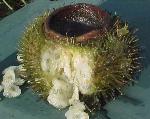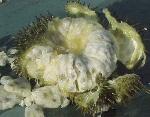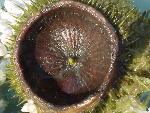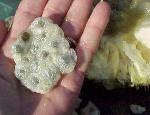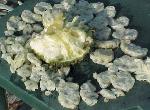Victoria Pods and Seeds -
Set to Collection
Click images to enlarge
Within a few days after pollination, Victoria flowers/seed pods follow a predictable cycle of development. The period from pollination to rupture of the ripe pod can be as little as 33 days to as long as 90 days depending on water temperature. If you want to produce your own seeds, click here.
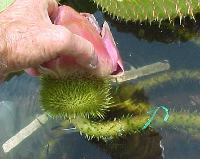 |
< The first thing it does is develop a "crook" in its neck, the stem curving to hold the pod upright. Then the stem begins its continuous elongation and curls into an "S" shape. > |
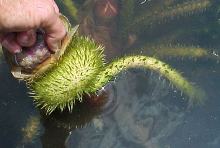 |
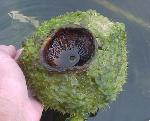 A
well set pod will swell markedly over this period. Poorly set
pods may have only small bulges here and there. Quality of set
can be seen about halfway through ripening though prospective
seed number is impossible to gauge. We have noted that early
season pods tend to produce more and smaller seeds than late
season pods, which tend to produce fewer and larger seeds, on
the same plants.
A
well set pod will swell markedly over this period. Poorly set
pods may have only small bulges here and there. Quality of set
can be seen about halfway through ripening though prospective
seed number is impossible to gauge. We have noted that early
season pods tend to produce more and smaller seeds than late
season pods, which tend to produce fewer and larger seeds, on
the same plants.
Collecting seeds from cultivated plants is easily accomplished by placing a slightly perforated ziplock bag around the pods when they return near the surface of the water. Often there will be a little foam evident in the bag the day before rupture. At actual rupture, the thorny skin will begin to dissolve, releasing the seeds surrounded by their arils (floatation sacs) toward the surface (or up into the bag). The stem returns rapidly to the bottom, we suppose an additional mechanism to float the seeds away from the plant.
Collectors in the wild should look for pods that are at or very near the surface of the water, swollen and on straight stems. Pods near the crown or deep in the water will be immature. When possible whole pods that have been collected should be floated in buckets or tubs until they rupture on their own. This is easier than trying to extract slightly less than mature seeds from a still hard pod.
Though collecting seeds when the pods rupture naturally is the most desirable to assure fully ripe seeds, sometimes weather or schedules dictate that pods must be cut off prematurely. These can be floated in greenhouse tubs until they rupture. We have done experiments that indicate the pods do not continue to develop once removed from the plants but this may only be in our conditions.
Mature seeds will be firm, olive green, brown or greenish brown. Pale seeds are immature, "squish" easily and are unlikely to be viable. Black seeds are likely to have been stored for an extended period of time and their viability should be questioned. Seeds that float have probably been allowed to dry out and should be discarded.
Once the arils have been removed, seeds should be stored in water, either in jars or plastic bags, at temperatures recommended in the Victoria Cultivation Guide.
|
|
||
|
|
|
Articles |
|
|
|
|
|
|
|
|
